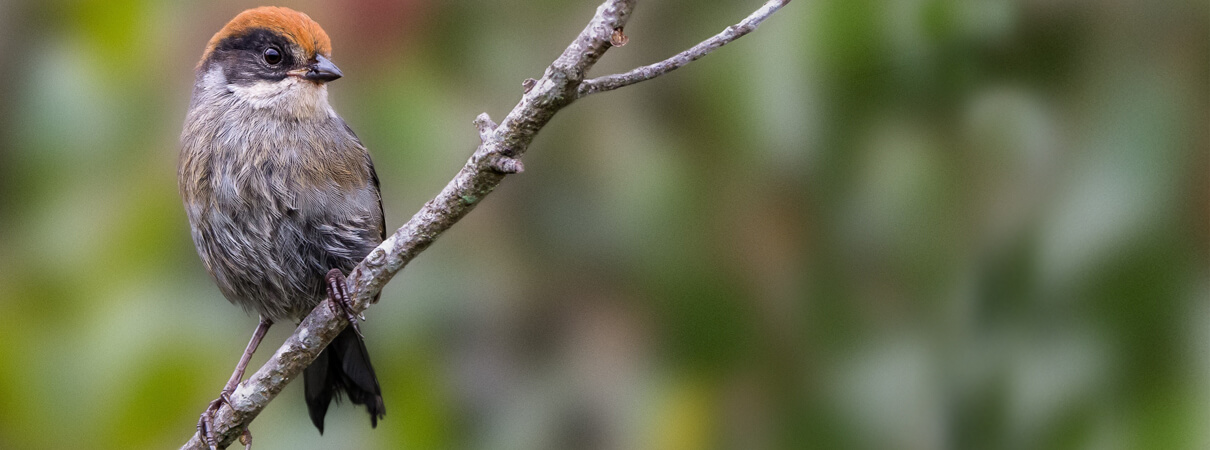
Antioquia Brushfinch range map, Birds of North America, https://birdsna.org maintained by the Cornell Lab of Ornithology.
The Antioquia Brushfinch was first described in 2007, but only on the basis of three museum specimens. A live bird was not found in the field until 2018, when an unfamiliar brushfinch was spotted by a keen-eyed agronomist on his way to weekly mass on the outskirts of Medellín, Colombia.
This newly rediscovered relative of Ecuador's Pale-headed Brushfinch joins the ranks of some of the rarest birds in the Western Hemisphere, including the Blue-eyed Ground-Dove, Bahama Nuthatch, and Stresemann's Bristlefront.
A Race to Rescue Habitat
The scarcity of this species is mainly due to habitat loss. The little native habitat that remains is found only in small patches of native scrub dotting the pastoral countryside outside of Medellín, in the area known as “Altiplano Norte de Antioquia.” Since 2018, more than 300 acres of land where the Antioquia Brushfinch was recorded — including the place where it was rediscovered — have been converted to cattle pasture or potato crops. The remaining habitat is under severe threat of conversion.
The species has been found in 25 locales, but fewer than 100 birds have been seen so far. They are usually observed in couples and occasionally in small family groups. ABC and partners conduct annual surveys to monitor the species and to produce a global population estimate.

Antioquia Brushfinch by Yovany Ochoa
Naming a New Brushfinch
The Antioquia Brushfinch belongs to a group of large sparrows found in humid mountain forests from Mexico south to Argentina. It's a large towhee-like bird with a rusty crown, a contrasting black mask around the eyes, and a white throat. Except for a few subtle fieldmarks, the Antioquia Brushfinch resembles the more widespread Slaty Brushfinch, with which it was initially confused.
The Antioquia Brushfinch's species name, blancae, refers to the bird's pale underparts. It also refers to the Colombian lepidopterologist Blanca Huertas, the wife of ornithologist Thomas M. Donegan, who described the new bird.
A Successful Template for Saving a Species
Similarly range-restricted and related species provide prime examples of how this species can be saved. ABC's partner in Ecuador, Fundación Jocotoco, was able to bring back the population of the Critically Endangered Pale-headed Brushfinch through timely habitat protection and management. When that species was rediscovered in 1998, fewer than 70 individuals remained. The total population of Pale-headed Brushfinch now numbers more than 200.
Critical Conservation Efforts
ABC continues to support and join local researchers in the search for remaining Antioquia Brushfinch habitat and to identify areas suitable for protection. This work is part of ABC's larger effort to rediscover and conserve “lost” bird species.
In October 2019, ABC, partner groups, and 85 volunteers joined forces to look for new locations for the Antioquia Brushfinch. This first buscatón (“big search”) found about 25 Antioquia Brushfinches in five new locales. In 2020, during the second buscatón, searchers visited 20 localities and obtained 85 records of the species. The third buscatón was conducted in March 2022, when 38 volunteers found the rare songbird in 13 of the 15 localities visited, with 85 records total.
In addition, ABC is working with the local community to protect priority lands for the species. In 2021, ABC supported efforts of our local partner Corporación SalvaMontes, which signed conservation agreements with landowners to protect a total of 351 acres of habitat on a private farm, commercial tree plantation, and a military base. Also in 2021, ABC helped partner Fundación Guanacas expand the existing Gaunacas Reserve through the purchase of three parcels where the Antioquia Brushfinch had been observed, totaling 239 acres.
Corporación SalvaMontes, with ABC support, is undertaking activities with a native blueberry species, locally known as mortiño, in an effort to protect the species' habitat while generating farmer income. Partners are also exploring the use of silvopasture, including the balanced use of trees, forage plants, and livestock. Local silvopasture experts at the Colombian agricultural research organization CIPAV are collaborating on this effort, educating local dairy farmers and taking them to exemplary silvopasture farms for a firsthand look at this form of sustainable agriculture.
These partner efforts on working lands will create habitat corridors that enable isolated Antioquia Brushfinch populations to connect — ultimately enhancing the species' viability and prospects for long-term survival.
Donate to support ABC's conservation mission!



















































